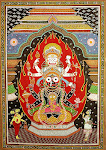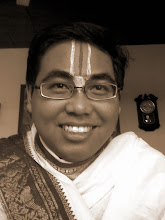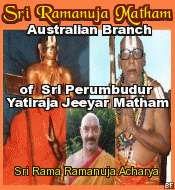The ceremony actually can lead by the senior member of the family. But after past three generations we use paid Pandit (Pemangku). First he will do sankalpa on behalf of the whole family. He recalled the day, month, year, place, and finally our intention to invite the Bhataras for feasting on commemoration of their inauguration day.
 The Pandit sat cross-legged on the ground for humbly inviting the Bhataras. First he purifying himself than the ritual begins. He invokes the Lord Ganapati, elephant-headed god, pray for protection. Then he invokes the Bhataras begin from our vastudevatas, sthanadevatas, gramadevatas, the navagrahas, the eight lokapalas. He performs puspanjali to the seven sages and the Mahadevas. After that he invite our ancestors to attend the function by saying in archaic Javanese, “Let our revered elders came together for the feasting, joyfully worshiping the Devas, Mahadevas, and The Lord of Your Family, Who was told to me as The Lord of Seven Hill, offering your obeisance toward The Lotus feet of The Lord known as Kesava, Hrisikesha, Govinda, Janardana, and Padmanabha.” (sinembah sira sang bhatara kabeh maring padanta sanghyang kuladevatanta, sang rajabhatara maraga iswaraning saptagiri anghaturaken puja stuti panganjali ri pada juga hyang kesava, hrsikesa, govinda, janardana, padmanabha, kadi kawruhaken ing mami )”. Lord of Seven Hills is one of many names of Lord Vishnu, Whose temple was located on the top of Thirumala Hill, a sacred pilgrimage place for Hindus. The South Indians preferred to call Him Lord Srinivasa and in the North He was famous as Lord Balaji. This most famous Hindu shrine of Lord Srinivasa was the richest religious institution in the world. More than 10.000 pilgrims were visiting this holy site everyday. When my "first" ancestor came to Nusantara, he could be a devout worshipper of this Divine Form of Our Lord. Thus He became our Family Deity (kuladevata).
The Pandit sat cross-legged on the ground for humbly inviting the Bhataras. First he purifying himself than the ritual begins. He invokes the Lord Ganapati, elephant-headed god, pray for protection. Then he invokes the Bhataras begin from our vastudevatas, sthanadevatas, gramadevatas, the navagrahas, the eight lokapalas. He performs puspanjali to the seven sages and the Mahadevas. After that he invite our ancestors to attend the function by saying in archaic Javanese, “Let our revered elders came together for the feasting, joyfully worshiping the Devas, Mahadevas, and The Lord of Your Family, Who was told to me as The Lord of Seven Hill, offering your obeisance toward The Lotus feet of The Lord known as Kesava, Hrisikesha, Govinda, Janardana, and Padmanabha.” (sinembah sira sang bhatara kabeh maring padanta sanghyang kuladevatanta, sang rajabhatara maraga iswaraning saptagiri anghaturaken puja stuti panganjali ri pada juga hyang kesava, hrsikesa, govinda, janardana, padmanabha, kadi kawruhaken ing mami )”. Lord of Seven Hills is one of many names of Lord Vishnu, Whose temple was located on the top of Thirumala Hill, a sacred pilgrimage place for Hindus. The South Indians preferred to call Him Lord Srinivasa and in the North He was famous as Lord Balaji. This most famous Hindu shrine of Lord Srinivasa was the richest religious institution in the world. More than 10.000 pilgrims were visiting this holy site everyday. When my "first" ancestor came to Nusantara, he could be a devout worshipper of this Divine Form of Our Lord. Thus He became our Family Deity (kuladevata).Now the Pandit offers some water to wash the Bhatara’s feet, their hand, and sipping for refreshment. Then he told the Bhataras to purifying themselves before attending the feast of Our Family Deity. He told our relatives to circulate some containers of consecrated holy water and ceremoniously sprinkled them to all shrines and other holy structures all over the house. Meditatively we thought that the attending Bhataras have come to the function freshly bathed and sanctified. Next offering were articles for face make up. Scented water, perfumes, fragrant powder, herbal oil for hair, and flowers. Their essences weave toward the shrines by chanting some prayer indicating the offered articles. The last articles were one set of clothing and jewel, also offered by same procedure.
Then the Pandit left his seat on the ground and take new position on a pavilion with platform full of food offerings. Because we have two main Kemulan shrines, we also have bigger pavilion with two platforms for each shrine. Once my ancestor has no male progeny, only one girl. Because there’s no other way, the “princess must become prince” to inherit the house and its wealth. So the daughter has to change her status socially as son. When the time of marriage came, then the bridegroom spiritually converted to the status of a wife not a husband. So the husband (but wife in social status) has to take his ancestral shrine to his wife’s house (now with the status of a husband, the legal heir of the house). So we have two main shrines till now.
Back to the feast, now the Pandit offered the whole articles first to the highest Bhatara, our Kuladevata The Lord of Saptagiri (I don’t know about other Balinese family). Then in descending order to the other Mahadevas, Devas, and Bhataras. But we have to remember that there were attending ancestors and lesser Bhataras that have no right to directly take the offerings. So now the Pandit led us to weave the essences of Prasada to these certain Bhataras.
After the Bhataras got their feast, we perform sembah, anjali namaskara, and offered puspanjali, respectfully fold our hand and rise them up, offered oblations of flowers at the feet of attending Bhataras. Then the same procedures were repeated by offering water for sipping, wash hand, and feet. After that the Bhataras were gave farewell and send back to their respective abodes. The whole ceremony was over by taking Sripada-tirtha (holy water) and consecrated rice mixed with turmeric and sandalwood paste, similar with akshata-prasada, called bija in Bali, and of course did our own feast with the leftover foods of the Bhataras.
All temples and all family shrines have their own “Birthday Celebration” at certain auspicious day. A bigger temple or more famous one with many followers will have more elaborate festivals even continued for days. The great temples of the Cardinals Patron Devatas and the temples at the complex of Besakih, the Mother Temple, could have full one month feast. The higher the rank of the presiding Bhatara, many more his equal colleagues and lesser Bhataras should be invited to his feast. Also many people from so many places will come to offer obeisance, then more time will be needed to accommodate all of them. So from initial avahana (invoking rites) to final visarjana (farewell rites) of the Bhataras will take longer time.




































































